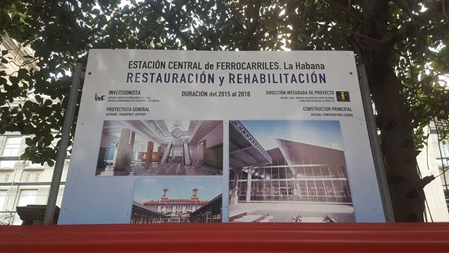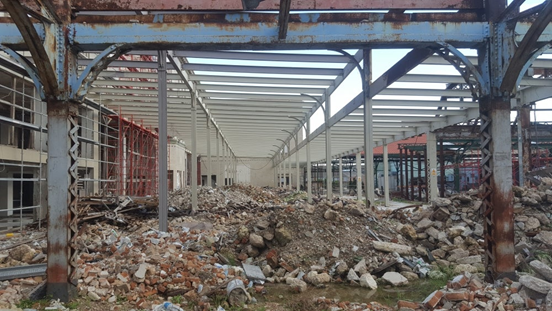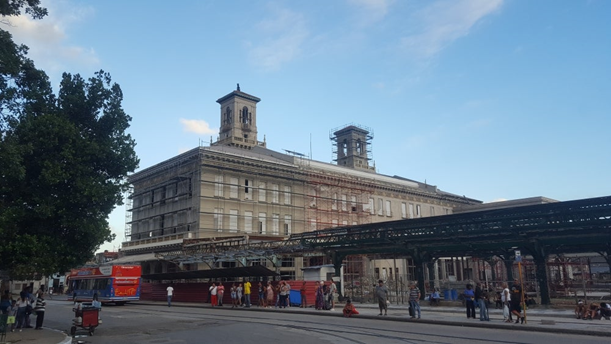
Cubanet, Miriam Celaya, Havana, 20 November 2019 — Seventy-five years after the opening of the first railway station in Cuba (Bejucal, 1837), Havana’s Central Railway Station was built and inaugurated, and its construction – finished in just two years – was carried out under the government of José Miguel Gómez by The Frederick Snare Corporation, an American company.
The brand-new station – completed on November 30, 1912 – was an imperative for the capital, since the old Villanueva station (1859) did not meet the requirements of a growing population. Equipped with a colorful four-story building, a mezzanine, a large 151,000 square feet train yard and a colorful eclectic façade with two elegant towers, central clock and craft decorations of shells and shields on the wall, the “Train Station” – as it is known by Havana’s residents – stands on the corner of Egido and Arsenal Streets, in the historic area of the capital.
In 1983 it was recognized as a National Monument for “its architectural and historical values,” but even this jewel of Havana’s architecture could not escape official neglect or the system’s own decline, especially when accelerated by the fall of the USSR, which marked the beginning of the economic crisis of the 1990’s.
The deterioration of the rail passenger transportation service and the Central Station itself occurred simultaneously, and after some cosmetic refurbishment, works that did not solve the constructive or functional problems that already demanded major investments, it finally stopped providing services in 2015. It was then closed for restoration and rehabilitation, to confront the major repairs that are now being carried out, which should have been completed in 2018, as is indicated by a large sign placed on the fence that surrounds its façade.

However, it’s enough to walk near the vicinity of the building and its related facilities to realize that not only have the completion deadlines have been breached, but that we will not be able to attend its re-inauguration at any time in the remainder of 2019, though in February of this year an optimistic report of the official site Cubadebate assured us that workers were laboring intensely in double shifts in order to deliver the finished work in time for the celebration of the 500th anniversary of Havana.
Back then, there was talk of “a 100-day delay” with respect to the original program, due to “the importation of steel for the stabilization of the north tower, as well as other materials for the façade,” to which should be added such complexities as the works required to strengthen the towers; the remodeling of the façade, retaining all its decorative and traditional values; the renovation of the blacksmith and carpentry shops; the creation of new rooms; the installation of escalators; the installation of new air conditioning services; lighting; and comfortable furniture sufficient to meet the demands of “more than 16 thousand daily travelers.”
Among the “renewal pride” which will be added to the services, the referenced report mentioned Wi-fi service and retail shops, which — it stated – would place the Central Station at the same level as its world peers.
On the other hand, it is said that the platforms are also undergoing restoration, but though the report ensures that “all their steel was restored” and that “the pluvial system was rebuilt from scratch,” in fact, today the train yard offers an image of chaos and debris scattered throughout almost all of its spaces. Nothing evidences the existence of platforms, much less rain lines or systems.

Obviously, if it were the restoration of one of the “mixed capital” hotels or some other work of greater interest to the authorities, the delivery program could have been fulfilled. But in the case of an installation designed to serve primarily nationals – and therefore not constituting a promising source of hard currency income, at least as long as there are no more efficient and comfortable locomotives and cars that meet the standards for foreign visitors. Thus, to date, there are no foreign investors who will inject enough capital to complete the work.
If the published data is assumed to be true, in this case the construction work of the Central Station – whose project was formulated by Cuban architects and engineers in coordination with the Office of the Historian – is the responsibility of the Transportation Ministry, the Union of Railways of Cuba, the Ferrocarriles de Occidente Company and the Havana Base Business Unit, so there is no need for much optimism.
This November 19th will be the 187th anniversary of the inauguration of the first railway station in Cuba and the beginning of this means of transportation on the Island; the second one in this Hemisphere – just behind the US railroad – and the first railroad system in Latin America.
The anniversary, however, should be a cause of shame and not pride. The collapse of the Cuban railways, evident in the rail infrastructure, as well as in locomotives, freight and passenger wagons and stations, is an incontestable sample of the destructive capacity of a socio-political and economic system that only needed 60 years to destroy what was built over the previous 127 years.
Moreover, the Castro regime not only spoiled the previously efficient railway capability of the Island, but it also interrupted the existence of a sector with a long working tradition in Cuba.

Today the workers of the depressed railway sector ignore that it is next Tuesday, November 19th – and not January 29th, the date imposed in 1975 by Fidel Castro’s egomania – when they should be honored. Recovering the rail efficiency achieved during the 19th century and the beginning of the 20th century, almost 200 years after the first train circulated in Cuba, remains an aspiration.
Translated by Norma Whiting

